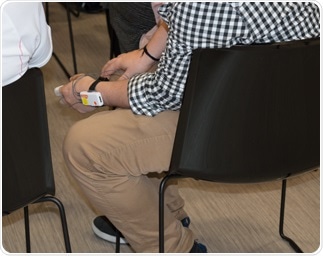When it comes to which advertisements trigger the greatest response in viewers, a recent GfK pilot looking at ads screened around a live World Cup game found that, on average, ads based around humor achieved a higher biometric response and a higher stated response that those themed around athletics, product benefits or emotional pull.

NeuroLynQ Sensor worn on the hand
GfK, a global data and analytics provider, and Shimmer Research, a leading provider of wearable wireless sensor products, monitored the physiological responses of participants as they watched the live France-Peru World Cup game - including 21 advertisements from a variety of product categories that were shown before the game or at halftime.
As well as tracking the audience’s second-by-second skin response and heart rate as each advertisement played, GfK also recorded their stated response to each advertisement at the end of the session. The physiological response is recorded by a wearable biometric device, which sits on a participant’s wrist and picks up the signals via two electrodes.
Top 5 ads for physiological response
Of the 21 ads tested within this environment (an audience anticipating a big sporting event), Ladbrokes ad triggered the greatest overall physiological response, with 65% of the audience showing a response, including 28% registering a high response. This is followed by McDonald's (55%, including 17% high response), William Hill (50%, including 20% high response), and VW (48%, including 17% high response). Royal Ascot and Kia tied in 5th place, with both triggering a response in 46% of the audience, but Royal Ascot’s ad managed 19% showing a high response, compared to Kia’s 14%.

Geoffrey Gill, President of Shimmer Americas, comments:
Viewing the biometric results in context lets us understand what is going on. For example, the response to the Royal Ascot promo appears to be due to the commentator in the ad also being the commentator in the World Cup game that was playing. So the audience instinctively associated the promo voiceover with their anticipation for the second half of the big game that they were in the middle of watching – and the promo benefited from that connection. This type of understanding can only be gained by studying the ad in context - as we are able to do with Shimmer’s NeuroLynQ system.”
Combining biometric and stated response changes the ranking
When the physiological responses (low/high engagement) to each advertisement are combined with the participants’ stated response (low/high appeal), the top three winners are the ads from Ladbrokes, McDonalds, and Kia. These score highly on both metrics, putting them into the “high engagement, high appeal” quadrant that indicates the most effective ads.
Eszter Boczan, who lead the research for GfK, states:
It is only when we look at both conscious and non-conscious responses that we get the full detail on what works and what doesn’t. That is why it is so important to integrate conscious measures in any type of Neuromarketing study.
For example, within the humorous ads, those with unexpected slapstick humor, like the Ladbrokes ad, or which make fun out of mundane everyday situations, like the McDonalds ad, performed better than those with more sophisticated humor, or ones in which the formula for the humor was already known and therefore expected.”
Key findings
- Overall, humorous ads trigger greater conscious and unconscious response than ads themed around athletics, product features or emotional pull, when screened around a big sporting event
- For the sports-themed ads, the best response was gained by those with lots of dynamic interaction between athletes, which showed faces of the athletes, not their backs, and including cheering or shouting.
- Ads featuring products or product benefits triggered lower conscious and unconscious response, with clear indications of a disconnection between the ads’ tone (product focus, business-like) and the audience mindset (anticipation, excitement, having fun)
Boczan concludes:
This kind of testing can be applied to any sort of exploratory research, whether that is concept testing, proposition testing, understanding behavior in a real-life setting (such as reacting to the layout of a retail environment), exploring usage habits or purchase behavior.”